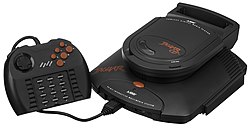| |
| Part of a series on the |
| History of video games |
|---|
The fifth generation era (also known as the 32-bit era, the 64-bit era, or the 3D era) refers to computer and video games, video game consoles, and handheld gaming consoles dating from approximately October 4, 1993, to March 23, 2006. [note 1] The best-selling home console was the Sony PlayStation, followed by the Nintendo 64 and the Sega Saturn. The PlayStation also had a redesigned version, the PSone, which was launched on July 7, 2000.
Contents
- History
- Transition to 3D
- CD vs cartridge
- Overview
- Aftermath of the fifth generation
- Changes in the industry
- Home systems
- Comparison
- Other consoles 2
- Worldwide sales standings
- Handheld systems
- Handheld comparison
- Other handhelds
- Milestone titles
- See also
- Notes
- References
Some features that distinguished fifth generation consoles from previous fourth generation consoles include:
- 3D polygon graphics with texture mapping
- 3D graphics capabilities – lighting, Gouraud shading, anti-aliasing and texture filtering
- Optical disc (CD-ROM) game storage, allowing much larger storage space (up to 650 MB) than ROM cartridges
- CD quality audio recordings (music and speech) – PCM audio with 16-bit depth and 44.1 kHz sampling rate
- Wide adoption of full motion video, displaying pre-rendered computer animation or live action footage
- Analog controllers
- Display resolutions from 480i to 576i
- Color depth up to 16,777,216 colors (24-bit true color)
This era is known for its pivotal role in the video game industry's leap from 2D to 3D computer graphics, as well as the shift in home console games from being stored on ROM cartridges to optical discs. This was also the first generation to feature internet connectivity: some systems had additional hardware which provided connectivity to an existing device, like the Sega Net Link for the Sega Saturn. The Apple Pippin, a commercial flop, was the first system to feature on-board internet capabilities.
For handhelds, this era was characterized by significant fragmentation, because the first handheld of the generation, the Sega Nomad, had a lifespan of just two years, and the Nintendo Virtual Boy had a lifespan of less than one. Both of them were discontinued before the other handhelds made their debut. The Neo Geo Pocket was released on October 28, 1998, but was dropped by SNK in favor of the fully backward compatible Neo Geo Pocket Color just a year later. Nintendo's Game Boy Color (1998) was the most successful handheld by a large margin. There were also two minor updates of the original Game Boy: the Game Boy Light (released in Japan only) and the Game Boy Pocket.
There was considerable time overlap between this generation and the next, the sixth generation of consoles, which began with the launch of the Dreamcast in Japan on November 27, 1998. The fifth generation ended with the discontinuation of the PlayStation (specifically its re-engineered form, the "PSOne") on March 23, 2006, a year after the launch of the seventh generation.


























